brake TOYOTA HIGHLANDER 2014 XU50 / 3.G Owners Manual
[x] Cancel search | Manufacturer: TOYOTA, Model Year: 2014, Model line: HIGHLANDER, Model: TOYOTA HIGHLANDER 2014 XU50 / 3.GPages: 712, PDF Size: 11.43 MB
Page 3 of 712
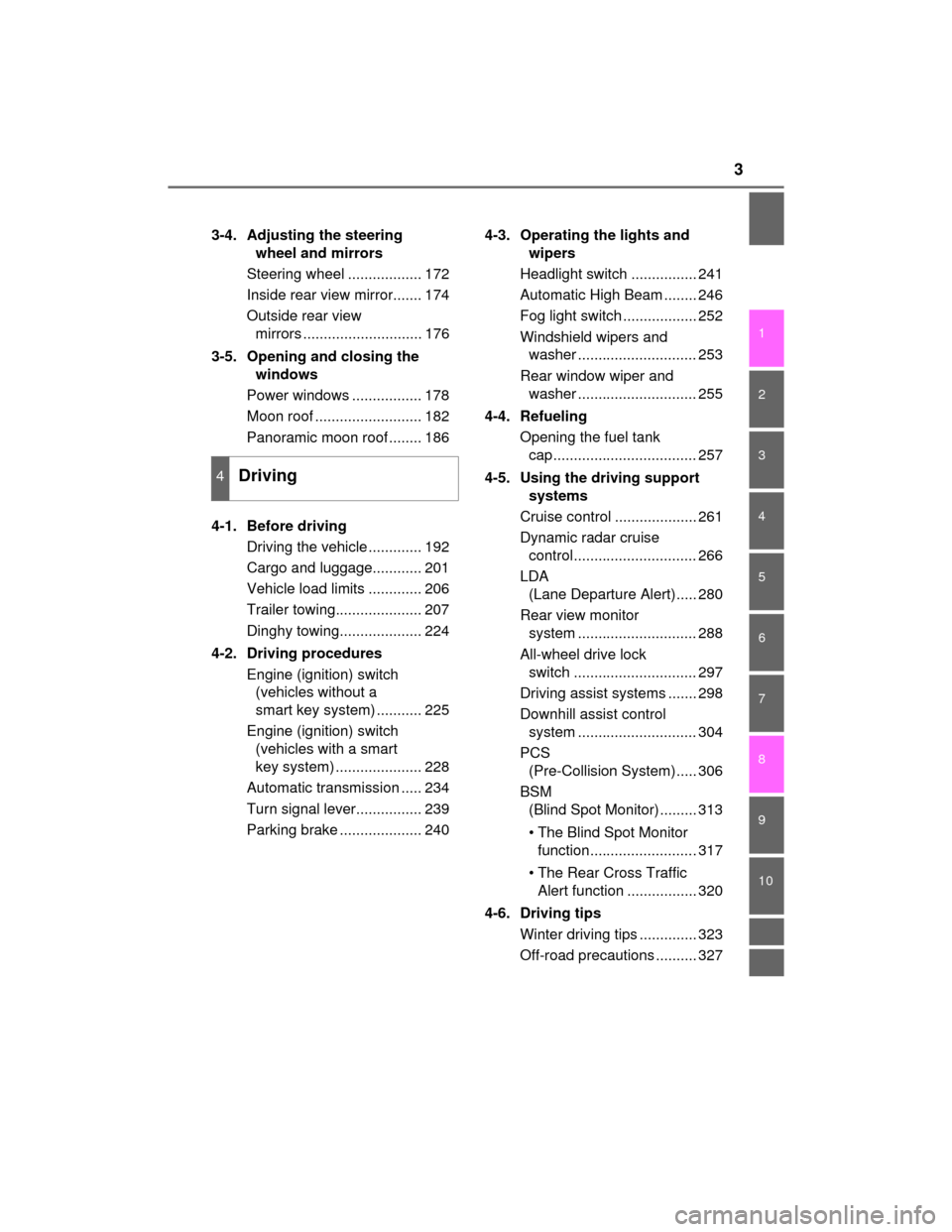
3
1
8 7
6
5
4
3
2
9
HIGHLANDER_U (OM48A12U)
10
3-4. Adjusting the steering wheel and mirrors
Steering wheel .................. 172
Inside rear view mirror....... 174
Outside rear view mirrors ............................. 176
3-5. Opening and closing the windows
Power windows ................. 178
Moon roof .......................... 182
Panoramic moon roof ........ 186
4-1. Before driving Driving the vehicle ............. 192
Cargo and luggage............ 201
Vehicle load limits ............. 206
Trailer towing..................... 207
Dinghy towing.................... 224
4-2. Driving procedures Engine (ignition) switch (vehicles without a
smart key system) ........... 225
Engine (ignition) switch (vehicles with a smart
key system) ..................... 228
Automatic transmission ..... 234
Turn signal lever................ 239
Parking brake .................... 240 4-3. Operating the lights and
wipers
Headlight switch ................ 241
Automatic High Beam ........ 246
Fog light switch .................. 252
Windshield wipers and washer ............................. 253
Rear window wiper and washer ............................. 255
4-4. Refueling Opening the fuel tank cap................................... 257
4-5. Using the driving support systems
Cruise control .................... 261
Dynamic radar cruise control.............................. 266
LDA (Lane Departure Alert)..... 280
Rear view monitor system ............................. 288
All-wheel drive lock switch .............................. 297
Driving assist systems ....... 298
Downhill assist control system ............................. 304
PCS (Pre-Collision System)..... 306
BSM (Blind Spot Monitor)......... 313
• The Blind Spot Monitor function.......................... 317
• The Rear Cross Traffic Alert function ................. 320
4-6. Driving tips Winter driving tips .............. 323
Off-road precautions .......... 327
4Driving
Page 9 of 712
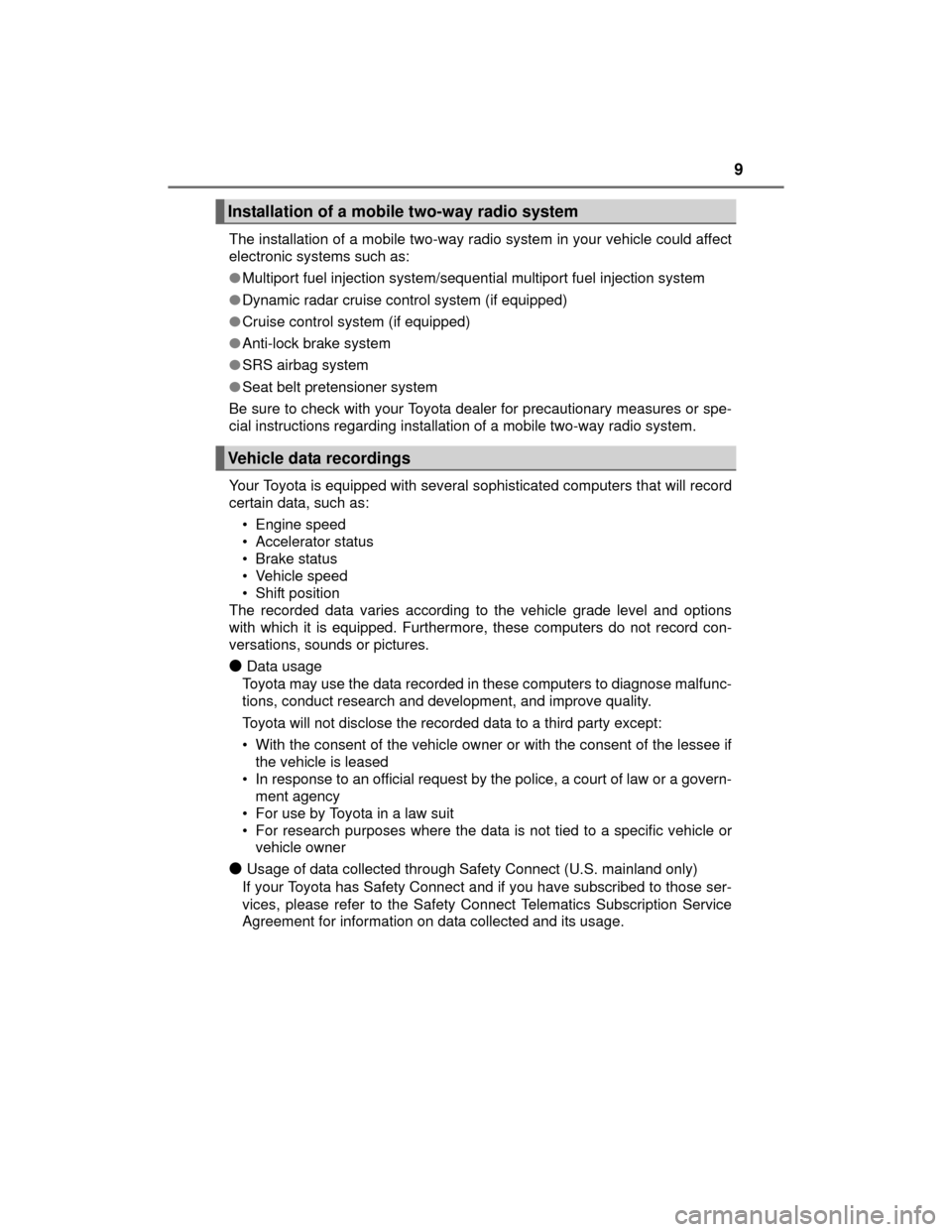
9
HIGHLANDER_U (OM48A12U)The installation of a mobile two-way radi
o system in your vehicle could affect
electronic systems such as:
● Multiport fuel injection system/sequential multiport fuel injection system
● Dynamic radar cruise control system (if equipped)
● Cruise control system (if equipped)
● Anti-lock brake system
● SRS airbag system
● Seat belt pretensioner system
Be sure to check with your Toyota dealer for precautionary measures or spe-
cial instructions regarding installation of a mobile two-way radio system.
Your Toyota is equipped with several sophisticated computers that will record
certain data, such as:
• Engine speed
• Accelerator status
• Brake status
• Vehicle speed
• Shift position
The recorded data varies according to the vehicle grade level and options
with which it is equipped. Furthermore, these computers do not record con-
versations, sounds or pictures.
●Data usage
Toyota may use the data recorded in these computers to diagnose malfunc-
tions, conduct research and development, and improve quality.
Toyota will not disclose the recorded data to a third party except:
• With the consent of the vehicle owner or with the consent of the lessee if the vehicle is leased
• In response to an official request by the police, a court of law or a govern- ment agency
• For use by Toyota in a law suit
• For research purposes where the data is not tied to a specific vehicle or vehicle owner
●Usage of data collected through Safety Connect (U.S. mainland only)
If your Toyota has Safety Connect and if you have subscribed to those ser-
vices, please refer to the Safety Connect Telematics Subscription Service
Agreement for information on data collected and its usage.
Installation of a mobile two-way radio system
Vehicle data recordings
Page 10 of 712

10
HIGHLANDER_U (OM48A12U)This vehicle is equipped with an event data recorder (EDR). The main pur-
pose of an EDR is to record, in certain crash or near crash-like situations,
such as an air bag deployment or hitting a road obstacle, data that will assist
in understanding how a vehicle’s systems performed. The EDR is designed to
record data related to vehicle dynamics and safety systems for a short period
of time, typically 30 seconds or less.
The EDR in this vehicle is designed to record such data as:
• How various systems in your vehicle were operating;
• Whether or not the driver and pass enger safety belts were buckled/fas-
tened;
• How far (if at all) the driver was depressing the accelerator and/or brake pedal; and,
• How fast the vehicle was traveling.
These data can help provide a better understanding of the circumstances in
which crashes and injuries occur.
NOTE: EDR data are recorded by your vehicle only if a nontrivial crash situa-
tion occurs; no data are recorded by the EDR under normal driving conditions
and no personal data (e.g., name, gender, age, and crash location) are
recorded. However, other parties, such as law enforcement, could combine
the EDR data with the type of personally identifying data routinely acquired
during a crash investigation.
To read data recorded by an EDR, special equipment is required, and access
to the vehicle or the EDR is needed. In addition to the vehicle manufacturer,
other parties, such as law enforcement, that have the special equipment, can
read the information if they have access to the vehicle or the EDR.
●Disclosure of the EDR data
Toyota will not disclose the data recorded in an EDR to a third party except
when:
• An agreement from the vehicle’s owner (or the lessee for a leased vehi- cle) is obtained
• In response to an official request by the police, a court of law or a govern-
ment agency
• For use by Toyota in a law suit
However, if necessary, Toyota may:
• Use the data for research on vehicle safety performance
• Disclose the data to a third party for research purposes without disclosing information about the specific vehicle or vehicle owner
Event data recorder
Page 17 of 712
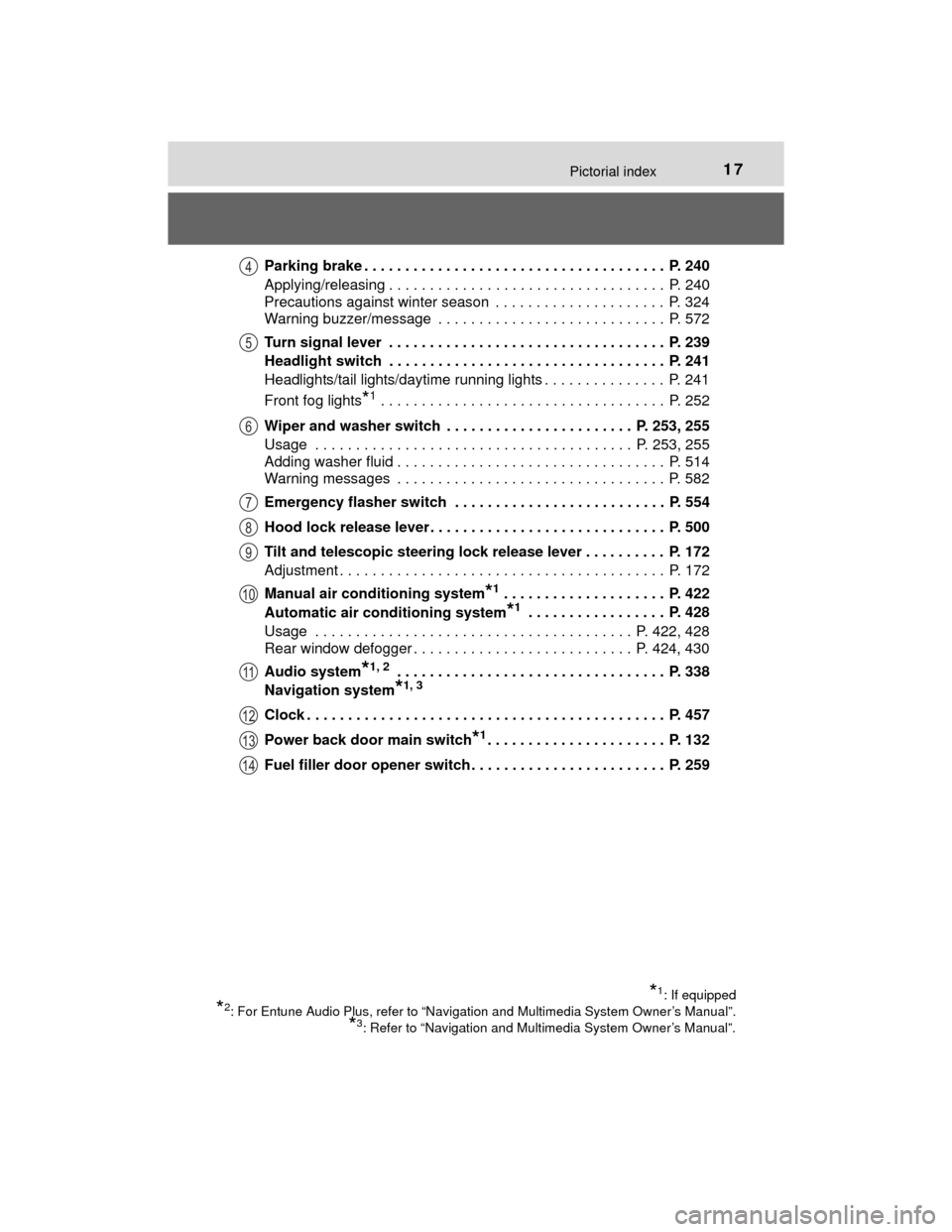
17Pictorial index
HIGHLANDER_U (OM48A12U)Parking brake . . . . . . . . . . . . . . . . . . . . . . . . . . . . . . . . . . . . . P. 240
Applying/releasing . . . . . . . . . . . . . . . . . . . . . . . . . . . . . . . . . . P. 240
Precautions against winter season . . . . . . . . . . . . . . . . . . . . . P. 324
Warning buzzer/message . . . . . . . . . . . . . . . . . . . . . . . . . . . . P. 572
Turn signal lever . . . . . . . . . . . . . . . . . . . . . . . . . . . . . . . . . . P. 239
Headlight switch . . . . . . . . . . . . . . . . . . . . . . . . . . . . . . . . . . P. 241
Headlights/tail lights/daytime running lights . . . . . . . . . . . . . . . P. 241
Front fog lights
*1 . . . . . . . . . . . . . . . . . . . . . . . . . . . . . . . . . . . P. 252
Wiper and washer switch . . . . . . . . . . . . . . . . . . . . . . . P. 253, 255
Usage . . . . . . . . . . . . . . . . . . . . . . . . . . . . . . . . . . . .\
. . . P. 253, 255
Adding washer fluid . . . . . . . . . . . . . . . . . . . . . . . . . . . . . . . . . P. 514
Warning messages . . . . . . . . . . . . . . . . . . . . . . . . . . . . . . . . . P. 582
Emergency flasher switch . . . . . . . . . . . . . . . . . . . . . . . . . . P. 554
Hood lock release lever . . . . . . . . . . . . . . . . . . . . . . . . . . . . . P. 500
Tilt and telescopic steering lock release lever . . . . . . . . . . P. 172
Adjustment . . . . . . . . . . . . . . . . . . . . . . . . . . . . . . . . . . . . . . . . P. 172
Manual air conditioning system
*1 . . . . . . . . . . . . . . . . . . . . P. 422
Automatic air conditioning system
*1 . . . . . . . . . . . . . . . . . P. 428
Usage . . . . . . . . . . . . . . . . . . . . . . . . . . . . . . . . . . . .\
. . . P. 422, 428
Rear window defogger . . . . . . . . . . . . . . . . . . . . . . . . . . . P. 424, 430
Audio system
*1, 2 . . . . . . . . . . . . . . . . . . . . . . . . . . . . . . . . . P. 338
Navigation system
*1, 3
Clock . . . . . . . . . . . . . . . . . . . . . . . . . . . . . . . . . . . . \
. . . . . . . . P. 457
Power back door main switch
*1. . . . . . . . . . . . . . . . . . . . . . P. 132
Fuel filler door opener switch . . . . . . . . . . . . . . . . . . . . . . . . P. 259
*1: If equipped
*2: For Entune Audio Plus, refer to “Navigation and Multimedia System Owner’s Manual”.
*3: Refer to “Navigation and Multimedia System Owner’s Manual”.
4
5
6
7
8
9
10
11
12
13
14
Page 89 of 712
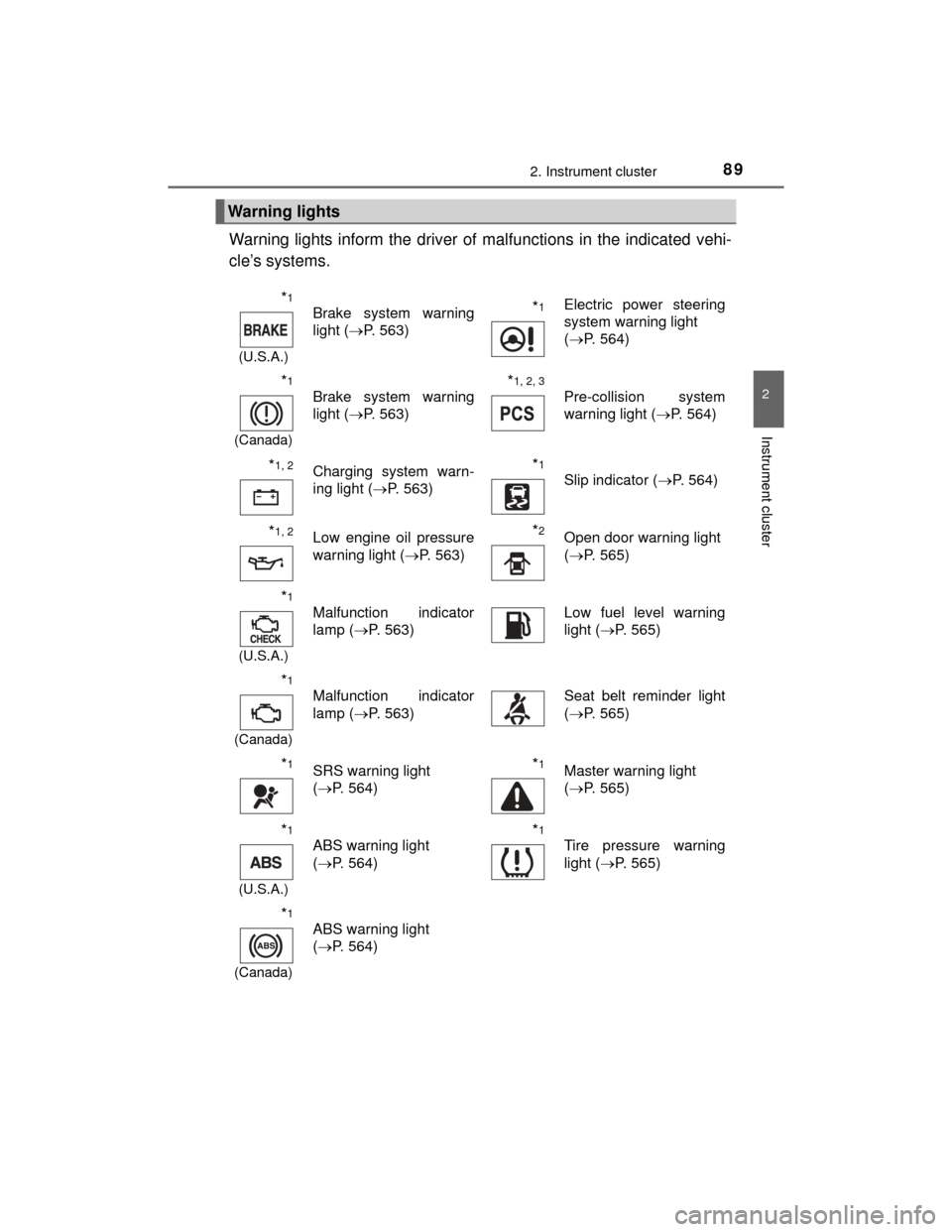
892. Instrument cluster
2
Instrument cluster
HIGHLANDER_U (OM48A12U)
Warning lights inform the driver of malfunctions in the indicated vehi-
cle’s systems.
Warning lights
*1
(U.S.A.)
Brake system warning
light (P. 563)*1Electric power steering
system warning light
(P. 564)
*1
(Canada)
Brake system warning
light ( P. 563)*1, 2, 3
Pre-collision system
warning light ( P. 564)
*1, 2Charging system warn-
ing light (P. 563)*1
Slip indicator ( P. 564)
*1, 2Low engine oil pressure
warning light (P. 563)*2Open door warning light
(P. 565)
*1
(U.S.A.)
Malfunction indicator
lamp ( P. 563)Low fuel level warning
light (P. 565)
*1
(Canada)
Malfunction indicator
lamp ( P. 563)Seat belt reminder light
(P. 565)
*1SRS warning light
(P. 564)*1Master warning light
( P. 565)
*1
(U.S.A.)
ABS warning light
(P. 564)*1
Tire pressure warning
light ( P. 565)
*1
(Canada)
ABS warning light
(P. 564)
Page 163 of 712
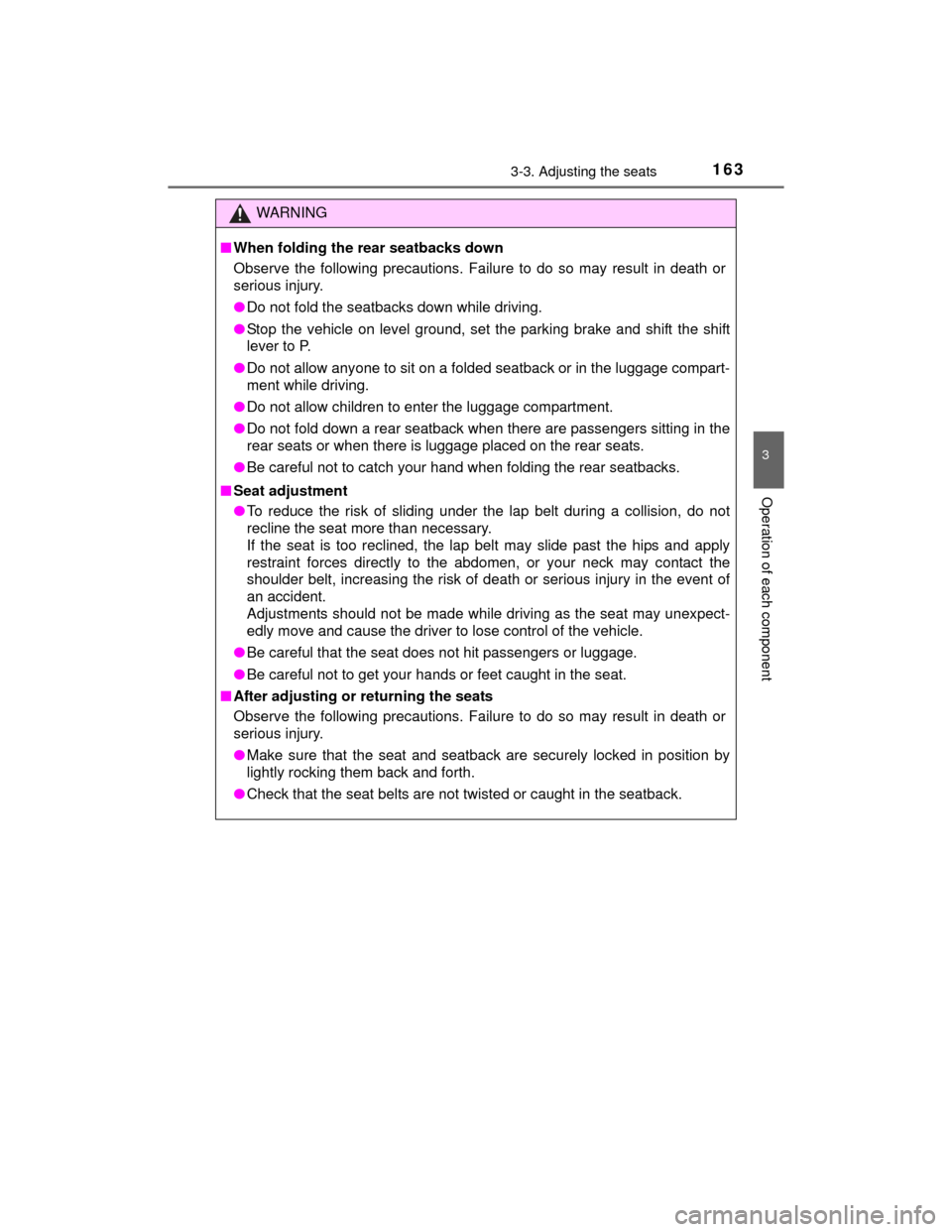
1633-3. Adjusting the seats
3
Operation of each component
HIGHLANDER_U (OM48A12U)
WARNING
■When folding the rear seatbacks down
Observe the following precautions. Failure to do so may result in death or
serious injury.
●Do not fold the seatbacks down while driving.
● Stop the vehicle on level ground, set the parking brake and shift the shift
lever to P.
● Do not allow anyone to sit on a folded seatback or in the luggage compart-
ment while driving.
● Do not allow children to enter the luggage compartment.
● Do not fold down a rear seatback when there are passengers sitting in the
rear seats or when there is luggage placed on the rear seats.
● Be careful not to catch your hand when folding the rear seatbacks.
■ Seat adjustment
●To reduce the risk of sliding under the lap belt during a collision, do not
recline the seat more than necessary.
If the seat is too reclined, the lap belt may slide past the hips and apply
restraint forces directly to the abdomen, or your neck may contact the
shoulder belt, increasing the risk of death or serious injury in the event of
an accident.
Adjustments should not be made while driving as the seat may unexpect-
edly move and cause the driver to lose control of the vehicle.
● Be careful that the seat does not hit passengers or luggage.
● Be careful not to get your hands or feet caught in the seat.
■ After adjusting or returning the seats
Observe the following precautions. Failure to do so may result in death or
serious injury.
●Make sure that the seat and seatback are securely locked in position by
lightly rocking them back and forth.
● Check that the seat belts are not twisted or caught in the seatback.
Page 191 of 712
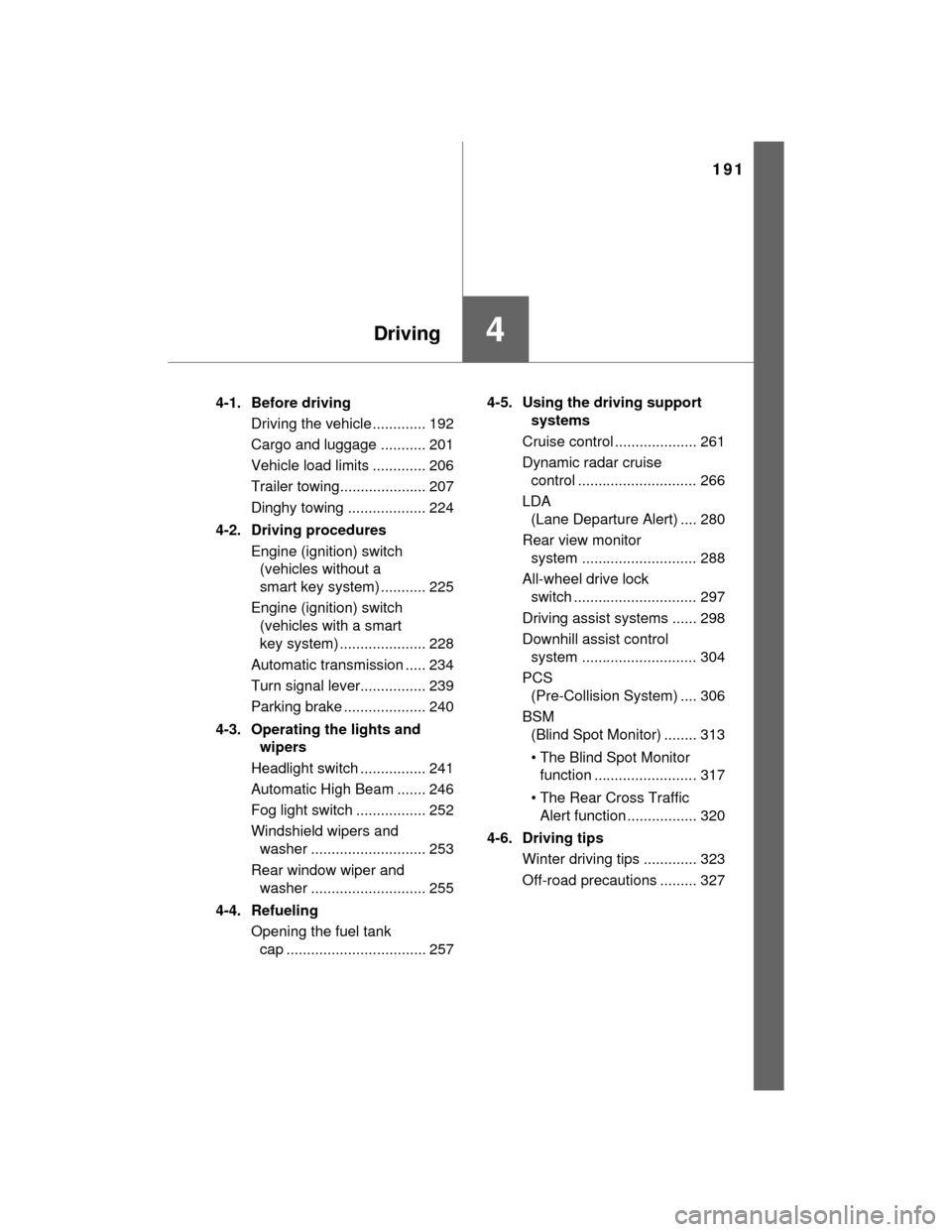
191
4Driving
HIGHLANDER_U (OM48A12U)4-1. Before driving
Driving the vehicle ............. 192
Cargo and luggage ........... 201
Vehicle load limits ............. 206
Trailer towing..................... 207
Dinghy towing ................... 224
4-2. Driving procedures Engine (ignition) switch (vehicles without a
smart key system) ........... 225
Engine (ignition) switch (vehicles with a smart
key system) ..................... 228
Automatic transmission ..... 234
Turn signal lever................ 239
Parking brake .................... 240
4-3. Operating the lights and wipers
Headlight switch ................ 241
Automatic High Beam ....... 246
Fog light switch ................. 252
Windshield wipers and washer ............................ 253
Rear window wiper and washer ............................ 255
4-4. Refueling Opening the fuel tank cap .................................. 257 4-5. Using the driving support
systems
Cruise control .................... 261
Dynamic radar cruise control ............................. 266
LDA (Lane Departure Alert) .... 280
Rear view monitor system ............................ 288
All-wheel drive lock switch .............................. 297
Driving assist systems ...... 298
Downhill assist control system ............................ 304
PCS (Pre-Collision System) .... 306
BSM (Blind Spot Monitor) ........ 313
• The Blind Spot Monitor function ......................... 317
• The Rear Cross Traffic Alert function ................. 320
4-6. Driving tips Winter driving tips ............. 323
Off-road precautions ......... 327
Page 192 of 712

192
HIGHLANDER_U (OM48A12U)
4-1. Before driving
P. 225, 228
With the brake pedal depressed, shift the shift lever to D.
( P. 234)
Release the parking brake. ( P. 240)
Gradually release the brake pedal and gently depress the accelera-
tor pedal to accelerate the vehicle.
With the shift lever in D, depress the brake pedal.
If necessary, set the parking brake.
If the vehicle is to be stopped for an extended period of time, shift the shift
lever to P or N. ( P. 234)
With the shift lever in D, depress the brake pedal.
Shift the shift lever to P. ( P. 234)
Set the parking brake. ( P. 240)
Vehicles without a smart key system:
Turn the engine switch to the “LOCK” position to stop the engine.
Vehicles with a smart key system:
Press the engine switch to stop the engine.
Lock the door, making sure that you have the key on your person.
If parking on a hill, block the wheels as needed.
Driving the vehicle
The following procedures should be observed to ensure safe
driving:
Starting the engine
Driving
Stopping
Parking the vehicle
1
2
3
1
2
1
2
3
4
5
Page 193 of 712

1934-1. Before driving
4
Driving
HIGHLANDER_U (OM48A12U)
Make sure that the parking brake is set and shift the shift lever to D.
Gently depress the accelerator pedal.
Release the parking brake.
■When starting off on an uphill
The hill-start assist control will activate. ( P. 298)
■ Driving in the rain
●Drive carefully when it is raining, because visibility will be reduced, the win-
dows may become fogged-up, and the road will be slippery.
● Drive carefully when it starts to rain, because the road surface will be espe-
cially slippery.
● Refrain from high speeds when driving on an expressway in the rain,
because there may be a layer of water between the tires and the road sur-
face, preventing the steering and brakes from operating properly.
■ Engine speed while driving
In the following conditions, the engine speed may become high while driving.
This is due to automatic up-shifting c ontrol or down-shifting implementation to
meet driving conditions. It does not indicate sudden acceleration.
● The vehicle is judged to be driving uphill or downhill
● When the accelerator pedal is released
■ Breaking in your new Toyota
To extend the life of the vehicle, observing the following precautions is recom-
mended:
●For the first 186 miles (300 km):
Avoid sudden stops.
● For the first 500 miles (800 km):
Do not tow a trailer.
● For the first 621 miles (1000 km):
• Do not drive at extremely high speeds.
• Avoid sudden acceleration.
• Do not drive continuously in low gears.
• Do not drive at a constant speed for extended periods.
Starting off on a steep uphill
1
2
3
Page 194 of 712

1944-1. Before driving
HIGHLANDER_U (OM48A12U)■
Drum-in-disc type parking brake system
Your vehicle has a drum-in-disc type pa rking brake system. This type of brake
system needs bedding-down of the brake shoes periodically or whenever the
parking brake shoes and/or drum are r eplaced. Have your Toyota dealer per-
form the bedding down operation.
■ Operating your vehicle in a foreign country
Comply with the relevant vehicle registration laws and confirm the availability
of the correct fuel. ( P. 635)
WARNING
Observe the following precautions.
Failure to do so may result in death or serious injury.
■When starting the vehicle
Always keep your foot on the brake pedal while stopped with the engine
running. This prevents the vehicle from creeping.
■ When driving the vehicle
●Do not drive if you are unfamiliar with the location of the brake and accel-
erator pedals to avoid depressing the wrong pedal.
• Accidentally depressing the accelerator pedal instead of the brake
pedal will result in sudden acceleration that may lead to an accident.
• When backing up, you may twist your body around, leading to a diffi- culty in operating the pedals. Make sure to operate the pedals properly.
• Make sure to keep a correct driving posture even when moving the vehicle only slightly. This allows you to depress the brake and accelera-
tor pedals properly.
• Depress the brake pedal using your right foot. Depressing the brake pedal using your left foot may delay response in an emergency, result-
ing in an accident.
● Do not drive the vehicle over or stop the vehicle near flammable materials.
The exhaust system and exhaust gases can be extremely hot. These hot
parts may cause a fire if there is any flammable material nearby.
● During normal driving, do not turn off the engine. Turning the engine off
while driving will not cause loss of steering or braking control, but the
power assist to these systems will be lost. This will make it more difficult to
steer and brake, so you should pull over and stop the vehicle as soon as it
is safe to do so.
However, in the event of an emergency, such as if it becomes impossible
to stop the vehicle in the normal way: P. 555